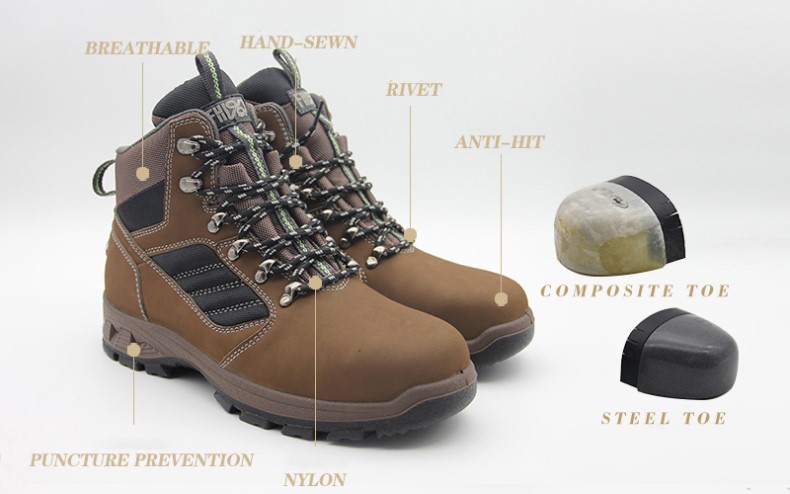Workplace injury is something that not everyone wants, and for women, safety needs to be further enhanced. Especially when working in dangerous environments, they need to wear the necessary and standard protective gear. Therefore, we would like to provide you with information about Composite Safety Shoes for Women. This will help you better understand Composite Safety Shoes.
What are Composite Safety Shoes?
Composite safety shoes are a type of work shoe that are designed to protect the wearer from hazards such as falling objects, electrical hazards, and slips and trips. They feature a composite toe cap, which is made from materials such as carbon fiber, plastic, or other lightweight composite materials. The composite toe cap is designed to protect the toes from impact and compression, providing an alternative to steel-toe safety shoes.
These shoes also often have slip-resistant soles to help prevent slips and falls, and may be insulated to protect against electrical hazards. They are designed to be lightweight and comfortable to wear, while still providing the necessary protection for the feet and toes.
Composite safety shoes are used in a variety of industries such as construction, manufacturing, and transportation, as well as for jobs that require standing or walking for long periods of time. They are suitable for both men and women and often come in a range of sizes and styles.
The composite toe cap provides protection which meets ASTM safety standard and may be an advantage over traditional steel-toe safety shoes as it is non-metallic, so they can pass through metal detectors without setting off any alarms.

About Composite Safety Shoes for Women
Composite safety shoes for women are a type of protective footwear that provide safety features such as slip resistance, electrical hazard protection, and puncture resistance. These shoes typically feature a composite toe cap, which is made from materials such as carbon fiber or plastic and is designed to protect the toes from impact and compression. They come in various designs and color which match with work uniforms and also help to maintain professional appearance.
They also often have slip-resistant soles to help prevent slips and falls and may be insulated to protect against electrical hazards. Many composite safety shoes for women are designed with women’s specific fits, to ensure a comfortable fit and proper support for the female foot. This type of footwear is suitable for women who work in industries such as construction, manufacturing, and logistics, where there is a risk of foot injuries from falling objects or electrical hazards.
It’s important to note that according to OSHA standards, safety shoes must be tested and certified by the American National Standards Institute (ANSI) or ASTM International. Employers are recommended to look for shoes with certifications and meeting OSHA requirements, to ensure the employees are safe and protected while they work.
Features of Composite Safety Shoes for Women
Composite safety shoes for women typically feature several key safety features to protect the wearer’s feet from hazards on the job. These features include:
Composite Toe: A composite toe is a non-metallic alternative to a steel toe that provides the same level of protection from falling objects and rolling objects.
Slip-Resistant Outsole: The outsole of composite safety shoes for women is often made with a slip-resistant material to help prevent slips and falls on wet or oily surfaces.
Electrical Hazard Protection: Composite safety shoes for women may also have electrical hazard protection, which provides insulation against electrical shocks.
Puncture-Resistant: Some composite safety shoes for women include a puncture-resistant plate in the sole to protect the wearer’s feet from nails and other sharp objects.
Waterproof: Some composite safety shoes are made waterproof, to keep the feet dry in wet condition.
Breathability: Some shoes have mesh or perforated parts to keep the feet ventilated.
Lightweight: Composite safety shoes are often lightweight than steel toe shoes, so they’re more comfortable to wear for long periods of time.
It’s important to note that while these safety features are important, they should also be combined with comfortable design and good fit to ensure the best protection and performance.
Benefits of Composite Safety Shoes for Women
Composite safety shoes for women provide several benefits over traditional steel-toe safety shoes. Some of the main benefits include:
Lightweight: Composite safety shoes are often lighter than steel-toe shoes, which can reduce fatigue for women who wear them for long periods of time.
Non-conductive: Composite materials do not conduct electricity, making composite safety shoes a safer option for women who work around electrical hazards.
Non-magnetic: Composite materials do not contain metal, which means composite safety shoes will not interfere with sensitive equipment or cause problems with security systems.
Weather Resistant: Composite safety shoes are not affected by temperature changes, making them suitable for use in extreme weather conditions.
Cost-effective: Composite safety shoes are often more cost-effective than steel-toe shoes, making them a more affordable option for employers who provide them to their employees.
Durable and Long Lasting: Composite materials can be made to be durable and long-lasting, allowing the shoes to withstand tough conditions.
Comfortable: Due to its lightweight nature, composite safety shoes can be made more comfortable for the user.

Bottom Line
In conclusion, composite safety shoes for women are a type of protective footwear designed to keep women safe in hazardous work environments. They offer a high level of protection, in a lightweight and non-conductive package. It is important to note that safety shoes should be worn in the appropriate work environment and that they should be well-maintained and replaced when they show signs of wear and tear.

